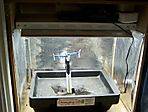So I have some 4'x8' white ABS plastic sheets I have used for multitude of projects. I have never had to cut long straight lines in this material before however I have cut pieces out of the middle using an angle grinder. The lines were acceptable for what I was doing at the time but they were somewhat 'wavy'. I am trying to construct a set of custom trays to fit in some nonstandard dimensions (28inches wide 3.5ft long).
So two questions: First can anyone offer advice on the best way to cut long straight lines in ABS? I am limited to hand tools (skil saw, rotozip, angle grinder, jig saw, table saw and similar tools).
Second, can anyone suggest how to 'weld' the corners together? I've read acetone will do the trick but I'm hoping someone here has attempted this project before and might be able to offer some advice or insight.
Thanks!
early
So two questions: First can anyone offer advice on the best way to cut long straight lines in ABS? I am limited to hand tools (skil saw, rotozip, angle grinder, jig saw, table saw and similar tools).
Second, can anyone suggest how to 'weld' the corners together? I've read acetone will do the trick but I'm hoping someone here has attempted this project before and might be able to offer some advice or insight.
Thanks!
early






